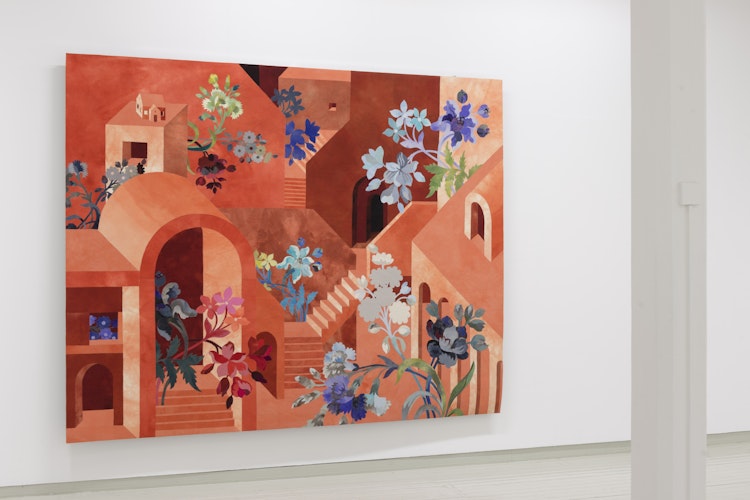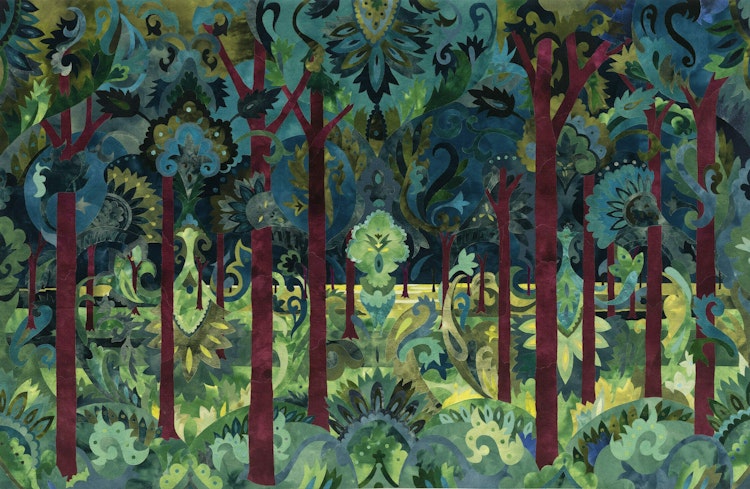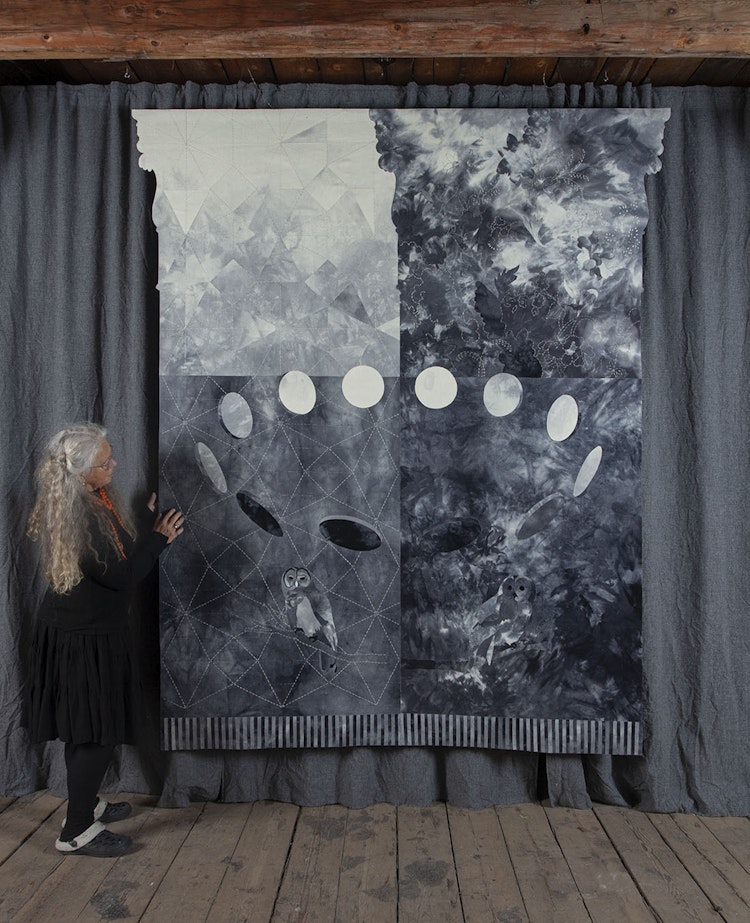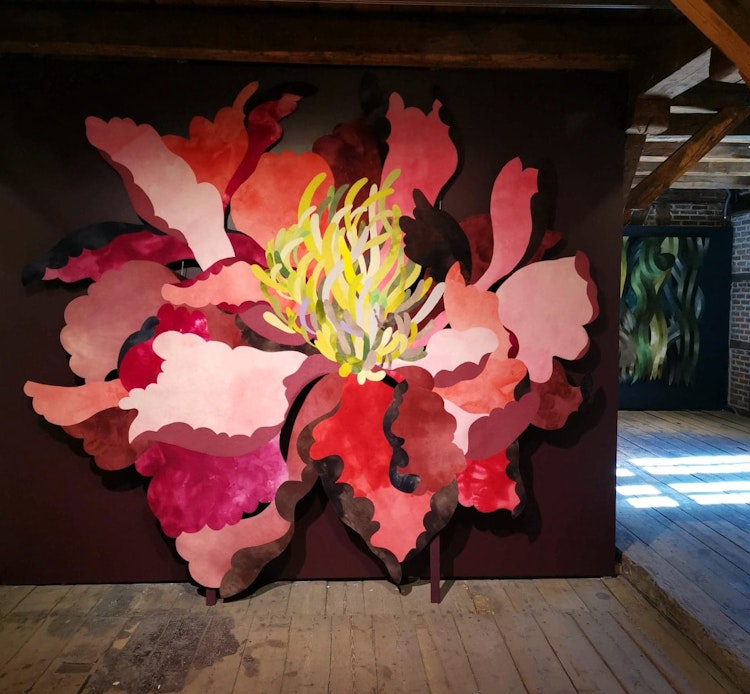

Marit Øydegard
Rasmussen’s artistic practice combines different expressions related to other craft traditions and painting. Her works are characterised by bold colours and geometric patterns juxtaposed with floral imagery. In this article by Marit Øydegard we get a closer look at the exhibition 'Retellings and Myths', a collaboration with Terje Nordby – a playwright, radio celebrity and ‘mythologist in private practice.’ The textiles themselves tell stories, but through Nordby’s reflections, they take on an added dimension.
Inger Johanne Rasmussen (b. 1958) studied textile arts at The National College of Art and Design in Bergen1, graduating with a ‘hovedfag’ (roughly equivalent to a Master’s Degree) in 1994. Prior to this, she studied at other schools including the University of Arts, Crafts and Design in Stockholm (1983-1984). Even though Rasmussen has consistently worked with textiles, her artistic expression relates also to painting and other craft traditions.
Visual variety
Over the past years, Rasmussen has held many solo exhibitions in museums and galleries and participated in group shows around the world. She has created numerous commissioned works for hospitals, schools, churches, and Norwegian embassies in Brussels, San Francisco, Tokyo, Beijing, Buenos Aires and Singapore.
Her last solo exhibition, entitled Retellings and Myths, opened on 22 January 2011 and consists of a large number of monumental textile pictures. Her motifs can easily be associated with textiles found in the home, for instance bedspreads and tablecloths, yet the patterns are intensified and considerably enlarged. In terms of visual expression, her works are rich in colour and the motifs range from geometric patterns and squares to organic, sinuous flowers. But despite this variation, the technique and materials are the same. Regarding Rasmussen’s choice of motifs, she says; ‘Many people think working with flower motifs is something a serious artist doesn’t do, but from my perspective, if you want to provoke, go for flowers rather than blood.’ Rasmussen uses felted wool and foot clothes, many of military origin, which she dyes and uses to create what she herself refers to as ‘inlaid textiles.’ She sews them by hand. It is therefore not the visual expression, but the format and technique, that create coherent unity in the exhibition.

‘Many people think working with flower motifs is something a serious artist doesn’t do, but from my perspective, if you want to provoke, go for flowers rather than blood.’
Collaborative process
Viewing these monumental textiles is like getting a glimpse of a myth you partially understand, in a language you barely know. Despite the dreamlike images, they are easy to relate to, as they call to mind stories and fairytales, or memories of visiting grandma as a child. The large textiles appear quite overwhelming in their colours and patterns, but their familiarity makes them approachable. Inspecting them up close, new aspects emerge which contribute to the story.
Yet another component adds to the experience of the exhibition: the recordings by writer and radio celebrity Terje Nordby. He has written texts for six of the textile pictures and recorded readings of each of the 6 to 9-minute-long passages. In the gallery, you can listen to the texts through headphones, download them on smart phones, or listen to the texts whilst looking at the textiles on YouTube. The texts generally concern well-known myths, and Nordby, through discussions with Rasmussen, manages to forge connections to the pictures. Nevertheless, these texts by no means reduce Rasmussen’s works into mere illustrations. Rather, they complement the textile pictures in ways that challenge us to piece together the different parts. Rasmussen gives us a clue: ‘The connection isn’t in the way the textile pictures are conveyed through colour, style, figure and form, but it can be found in their content.’
Radiance
By calling her textiles ‘retellings’, Rasmussen lets us know she is conscious about her methods. She reassembles elements from various stories and memories and, in this way, perpetuates the meaning of the elements, but also expands it by adding a new perspective. As Rasmussen herself says, it is essential for an artist to find her own story if she wants to realise what is important. As such, ‘retellings’ may be interpreted as a process of reflecting on the materials she uses, but also on the themes, figures, patterns, and shapes.
Rasmussen’s decision to use foot clothes from an army depot was first and foremost due to their visual and technical qualities. She has now started adding materials from other sources. Woven and felted wool is highly suitable for creating the magnificently luminous shades that are so characteristic of her work. In comparison to a painting, where the colour is on the canvas surface, Rasmussen’s colours penetrate the fabric and result in a saturated luminosity. Her colouring technique also allows a sort of flare, which adds light, life, and depth to her pictures.

Beauty, fairytales and myths
It is evident that Rasmussen and Nordby have been having deep discussions about the meaning of art and their own particular part in the contemporary art scene. Nordby questions whether it is possible to interpret contemporary art in relation to ideas about Dionysus and Apollo, especially in an age where we live in awe of timetables more than we worship gods. To bring progress to our daily life or the world in general, Nordby suggests, it is not enough to be strictly organised —we also need chaos. We need art, myths and fairytales in order to live a full life. This idea of balance between order and chaos is even evident in Rasmussen’s method of working: ‘I make chaos, tidy up, then make chaos again, and tidy up. I continue this balancing act as I try to get a balance between the two.’


Throughout Modernism, abstract and non-figurative art were dominant, and then Post-modern art came along and started commenting on itself. People began to ask what art was, as if it was an element: ‘But art must be what it is; it’s essential that it allows contemplation. We need stories,’ Nordby stresses.
Inger Johanne Rasmussen and Terje Nordby agree: it is high time for artists to resume commenting on subjects outside the field of art. ‘What is art for?’ – this is a question participant in the art world must continue to ask.